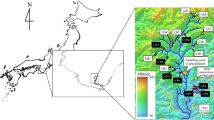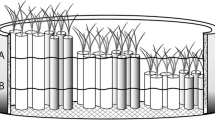Abstract
The natural density of red-backed salamanders, Plethodon cinereus, is 4–5 times greater at the New York study site in hardwood than in hemlock forests. The hypothesis that physico-chemical differences between forest types differentially affect the physiology of P. cinereus was tested. Salamanders were confined in individual enclosures in either a beech or a hemlock forest for 22 d. At the end of the enclosure period, they were analyzed for total body content of sodium, potassium, calcium, and magnesium, and for wet mass, dry mass, and body water concentration. Salamanders from the two forest types did not differ in any body parameter after the 22 d enclosure period. Also, the hypothesis that artificially acidified “rain” would inhibit the ability of salamanders to maintain ion balance was tested. Salamanders were confined for 34 d in individual enclosures in the two forests and exposed periodically to artificial rain of either pH 3 or pH 5. Soil pHs in the enclosures changed during the enclosure period, and artificial rain of both pHs caused soil pHs in the hemlock forest to increase even though pHs outside enclosures decreased. Enclosures that received artificial rain of pH 3 had lower soil pHs than enclosures that received artificial rain of pH 5. Salamanders in enclosures at pH 3 had reduced body sodium levels and tended to have lower body water concentration than salamanders in enclosures at pH 5 or controls. Thus, these terrestrial salamanders in a field setting demonstrated a physiological response to simulated acidic deposition consistent with the effects of exposure to acidic substrate previously observed in the laboratory. Since P. cinereus is frequently an abundant member of forest floor communities, and since it is sensitive to altered chemical inputs, it may be a useful indicator for assessing anthropogenic changes in ecosystems.
Similar content being viewed by others
References
Blair JM, Parmelee RW, Wyman RL (1994) A comparison of the forest floor invertebrate communities of four forest types in the northeastern U.S. Pedobiol 38:146–160
Burton TM, Likens GE (1975) Salamander populations and biomass in the Hubbard Brook Experimental Forest, New Hampshire. Copeia 1975:541–546
Elliott WM, Elliott NB, Wyman RL (1993) Relative effects of litter and forest type on rate of decomposition. Amer Midl Natur 129:87–95
Freda J (1986) The influence of acidic pond water on amphibians: A review. Water Air Soil Pollut 30:439–450
Freda J, Dunson WA (1984) Sodium balance of amphibian larvae exposed to low environmental pH. Physiol Zool 57:435–444
Freda J, Dunson WA (1985) Field and laboratory studies of ion balance and growth rates of ranid tadpoles chronically exposed to low pH. Copeia 1985:415–423
Freda J, Dunson WA (1986a) The effect of prior exposure on sodium uptake in tadpoles exposed to low pH water. J Comp Physiol 156B:649–654
Freda J, Dunson WA (1986b) Effects of low pH and other chemical variables on the local distribution of amphibians. Copeia 1986:454–466
Frisbie MP, Wyman RL (1991) The effects of soil pH on sodium balance in the red-backed salamander, Plethodon cinereus, and three other terrestrial salamanders. Physiol Zool 64:1050–1068
Frisbie MP, (1992) The effect of soil chemistry on sodium balance in the red-backed salamander: A comparison of two forest types. J Herpetol 26:434–442
Heatwole H (1962) Environmental factors influencing local distribution and activity of the salamander, Plethodon cinereus. Ecology 43:460–472
Horne MT, Dunson WA (1994) Behavioral and physiological responses of the terrestrial life stages of the Jefferson salamander, Ambystoma jeffersonianum, to low soil pH. Arch Environ Contam Toxicol 27:232–238
Jaeger R (1980) Microhabitats of a terrestrial forest salamander. Copeia 1980:205–208
Ma J (1994) A comparative study of cations and acid neutralizing capacity in four forest types of the Huyck Preserve in northeastern United States. In: Wyman RL, Barker C (eds) Combined 1990 & 1991 annual reports of the E. N. Huyck Preserve and Biological Research Station, Rensselaerville, NY pp 95–113
McDonald DG, Ozog JL, Simons BP (1984) The influence of low pH environments on ion regulation in the larval stages of the anuran amphibian, Rana clamitans. Can J Zool 62:2171–2177
Minitab (1986) Minitab reference manual. Minitab, Inc., State College, PA.
Mushinsky HR, Brodie ED Jr (1975) Selection of substrate pH by salamanders. Amer Midl Natur 93:440–443
Pierce BA (1985) Acid tolerance in amphibians. Bioscience 35:239–243
Pierce BA (1993) The effects of acid precipitation on amphibians. Ecotoxicol 2:65–77
Vernberg FJ (1955) Correlation of physiological and behavior indexes of activity in the study of Plethodon cinereus (Green) and Plethodon glutinosus (Green). Amer Midl Natur 54:382–393
Wyman RL (1988a) Soil acidity and moisture and the distribution of amphibians in five forests of southcentral New York. Copeia 1988:394–399
Wyman RL (1988b) Macroinvertebrates in leaf litter and humus, soil properties and amphibian density in four forest types on the E. N. Huyck Preserve during 1988. Annual report of the E. N. Huyck Preserve and Biological Research Station, Rensselaerville, NY pp 139–143
Wyman RL (1991) Multiple threats to wildlife: Climate change, acid precipitation, and habitat fragmentation. In: Wyman RL (ed) Global climate change and life on earth. Chapman and Hall, NY pp 134–155
Wyman RL, Hawksley-Lescault DS (1987) Soil acidity affects distribution, behavior, and physiology of the salamander Plethodon cinereus. Ecology 68:1819–1827
Wyman RL, Jancola J (1992) Degree and scale of terrestrial acidification and amphibian community structure. J Herpetol 26:392–401
Zotz G, Wolf B, Wyman RL (1986) The effects of habitat-type, soil acidity, soil structure and season on the density of the red-backed salamander, Plethodon cinereus on the E. N. Huyck Preserve (Urodela, Plethodontidae). 46th Annual Report of the E. N. Huyck Preserve and Biological Research Station, Rensselaerville, NY pp 78–87
Author information
Authors and Affiliations
Rights and permissions
About this article
Cite this article
Frisbie, M.P., Wyman, R.L. A field simulation of the effect of acidic rain on ion balance in a woodland salamander. Arch. Environ. Contam. Toxicol. 28, 327–333 (1995). https://doi.org/10.1007/BF00213110
Received:
Revised:
Issue Date:
DOI: https://doi.org/10.1007/BF00213110




